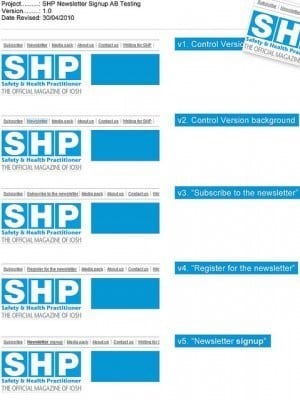
Those skilled in online marketing have been drawn to A/B testing in past couple of years. This website optimization practice allows you to pit two designs against each other in determining the best strategies in terms of marketing your product or service. You can test everything from landing pages, to sales emails and text copy in this process that increases the chance of receiving more subscriptions, sign-ups, and sales.
While it takes a slow and steady approach to begin to see the effects of a/b testing, in this article I’ll present some tips to keep in mind in maximizing the effectiveness of your blog and your bottom line.
Think Small
When engaging in an website optimization, it’s important to think small before you can reap big benefits. This applies to all aspects of your blog – from its navigation and sidebar, to offline efforts such as email marketing. One aspect to focus on specifically is your call to actions. Are people delving deeper into your blog through the various buttons on your site?
Your goal with a call to action is to make it sound warm and inviting in eliciting an immediate response from your viewer. These days, visitors to your site are more critical than ever, and don’t want to commit to something they don’t feel safe and secure about.
Always be running your call to actions through an a/b test to determine which words get people to try it the most often.
You may find “Sign up Now” or “30 Days Free” either sound like a big commitment or has the user focusing on the bill at the end. Alternative options may be:
Immediate Download
Watch Our Tutorial
Donate Today
Find Out More
Get a Free Quote Today
See It In Action
Limited Availability
These action phrases will inspire immediate response in the user’s mind, so be sure to test them out regularly.
Test Regularly
Test frequently to see a marked improvement in results. Results will range from no result, a negative result, or a positive result as the outcome of your tests. They key to reaching the results you’re looking for is to test regularly in achieving increased sales and/or conversions.
Once your blog is launched, be sure to test immediately. This will ensure you don’t lose conversions as a result of not having the website fully optimized.
When Am I Finished?
There’s a gray area in determining when to stop an a/b test. You don’t want to end too early and risk losing important information had you stuck it out. Testing too long could also mean the loss of sales had you switched to the new design element earlier. To determine how long to test, use a calculator like this one.
While the number varies from site to site, if you run a high-volume site, aim to have 70 conversions for one variant until you stop the test. Conversely, if you have a low-volume store with high-value items, it’s best to aim for 20 conversions. Exercise patience when dealing with the testing process, and go over every step to prevent inaccurate or unreliable results.
If you receive a much higher amount of traffic, it’s time to switch to multivariate testing, which allows you to test more than one element at a time.
Conclusion
In an increasingly saturated web, you need to employ as many techniques as possible to stand apart from the competition. A/B testing can be used to confirm that the design decisions you’ve made are successful, or re-evaluate what went wrong.
A/B testing software, and Google’s Website Optimizer, a free service will make the process of a/b testing much easier. Follow the advice in this article to achieve the results you’re looking for.
Ruben Corbo is a freelance writer that writes about several different topics in the field of internet marketing, gaming, art, and music. For more information about topics relating to multivariate testing or anything that will help you convert your high traffic into online sales, go to http://www.maxymiser.com















